Estimating Inter-Regional Freight Demand in China Based on the Input–Output Model
Abstract
:1. Introduction
2. Data Collection and Methodology
2.1. Data Collection
- (1)
- Input–Output table. The Input–Output table reflects the inter-relationship and balance between various departments in a certain period. China has systematically compiled regional input–output tables every 5 years since 1987 for its 31 provinces, with the latest version published in 2017. These tables divide sectors (S1–S42) into three industries: sector S1 represents the primary industry, sectors S2–S28 represent the secondary industry, and sectors S29–S42 represent the tertiary industry. In this study, the model parameters were calibrated using 2017′s date and validated against data from 2012 to 2020. The regional input–output tables for 31 provinces in 2017 were drawn from the China Regional Input–Output Tables 2017 [41].
- (2)
- Freight volume. We considered the total freight volume and freight exchange volume of roads, waterways, and railways across China’s provinces. The total freight volume for China’s 31 provinces from 2012 to 2020, sourced from the China Statistical Yearbook, was compared with the total freight volume simulated by the model. The freight exchange volume date for roadways, waterways, and railways from 2012 to 2020 were extracted from the China Transport Yearbook. These data were then summated to calculate the friction coefficient [42].
- (3)
- Economic data. We used data on the quantity and value of the main import and export of goods from the 2017 China Statistical Yearbook to calculate the product price ratio for the 23 sectors in the model. Subsequently, data related to the GDP and the structure of the three levels of industries in each of China’s 31 provinces from 2012 to 2020 were incorporated into our freight volume model. These data were also obtained from the China Statistical Yearbook [43].
2.2. Methodology
2.2.1. Creating Inter-Regional Input–Output Tables
- (1)
- Basic Principles
- (2)
- Direct consumption factor matrix
- (3)
- Inter-regional trade coefficient matrix
2.2.2. Converting Input–Output Table Values to Freight Volumes
3. Freight Volume Model Based on Inter-Regional Input–Output Table Model
3.1. Creating Inter-Regional Input–Output Tables Model
3.2. Converting Input–Output Table Values to the Freight Volume Model
3.3. Model Validation
4. Discussion
- (1)
- Only the first 23 sectors in the input–output table that resulted in freight exchanges were retained when the model was used to convert value into freight volume. These sectors belonged to the primary and secondary industry levels. Hence, the annual changes in the industrial structure should also be considered when determining the freight volume.
- (2)
- The model primarily used price to establish the relationship between value and freight volume. Therefore, it is important to consider not just the departmental pricing in a given year, but also the price changes for products across sectors over time and the impact of inflation.
5. Conclusions
- (1)
- An inter-regional freight volume forecasting model for China was developed based on the principles of the IO and the creation of inter-regional input–output tables derived from the corresponding tables of each province. This model calculated the impact of changes in the industrial structure on the freight volume simulations and determined the overall freight demand across regions, which could inform transportation infrastructure planning.
- (2)
- Converting the value into freight volume using the inter-regional input–output table required calculations based on department prices. However, each sector’s product quantity and value data were incomplete. The product price primarily relied on base year data, while data for other years were determined by the price and inflation rate of the base year, reducing the model’s calculation accuracy. The model was more accurate for predicting freight volume for the next five years due to inflation.
- (3)
- We performed a quantitative analysis of the forecasting results of the inter-regional freight volume model, examining the effects of changes in the structural makeup of the three industries. This research showed that the contribution of tertiary industries to the freight volume is relatively small. When the proportion of tertiary industries increased and the proportion of primary and secondary industries decreased, the freight intensity slowly declined and finally reached stability.
Author Contributions
Funding
Institutional Review Board Statement
Informed Consent statement
Data Availability Statement
Acknowledgments
Conflicts of Interest
References
- Huo, Z.; Zha, X.; Lu, M.; Ma, T.; Lu, Z. Prediction of Carbon Emission of the Transportation Sector in Jiangsu Province-Regression Prediction Model Based on GA-SVM. Sustainability 2023, 15, 3631. [Google Scholar] [CrossRef]
- Jin, G.; Feng, W.; Meng, Q. Prediction of Waterway Cargo Transportation Volume to Support Maritime Transportation Systems Based on GA-BP Neural Network Optimization. Sustainability 2022, 14, 13872. [Google Scholar] [CrossRef]
- Xu, X.; Chase, N.; Peng, T. Economic structural change and freight transport demand in China. Energy Policy 2021, 158, 112567. [Google Scholar] [CrossRef]
- Davydenko, I.Y.; Tavasszy, L.A. Estimation of Warehouse Throughput in Freight Transport Demand Model for the Netherlands. Transp. Res. Rec. 2013, 2379, 9–17. [Google Scholar] [CrossRef]
- Lu, B.; Wang, S.Y.; Kuang, H.B. Research on regional logistics demands forecasts based on the gravity model. Manag. Rev. 2017, 29, 181–190. (In Chinese) [Google Scholar] [CrossRef]
- Li, B.; Gao, S.; Liang, Y.; Kang, Y.; Prestby, T.; Gao, Y.; Xiao, R. Estimation of Regional Economic Development Indicator from Transportation Network Analytics. Sci. Rep. 2020, 10, 2647. [Google Scholar] [CrossRef] [PubMed] [Green Version]
- Rubio-Herrero, J.; Muñuzuri, J. Indirect estimation of interregional freight flows with a real-valued genetic algorithm. Transportation 2021, 48, 257–282. [Google Scholar] [CrossRef]
- Shen, L.; Shao, Z.; Yu, Y.; Chen, X. Hybrid Approach Combining Modified Gravity Model and Deep Learning for Short-Term Forecasting of Metro Transit Passenger Flows. Transp. Res. Rec. 2020, 2675, 25–38. [Google Scholar] [CrossRef]
- Shang, Q.; Deng, Y.; Cheong, K.H. Identifying influential nodes in complex networks: Effective distance gravity model. Inf. Sci. 2021, 577, 162–179. [Google Scholar] [CrossRef]
- Gragera, A.; Hybel, J.; Madsen, E.; Mulalic, I. A model for estimation of the demand for on-street parking. Econ. Transp. 2021, 28, 100231. [Google Scholar] [CrossRef]
- Aksenov, G.; Li, R.; Abbas, Q.; Fambo, H.; Popkov, S.; Ponkratov, V.; Kosov, M.; Elyakova, I.; Vasiljeva, M. Development of Trade and Financial-Economical Relationships between China and Russia: A Study Based on the Trade Gravity Model. Sustainability 2023, 15, 6099. [Google Scholar] [CrossRef]
- Li, J.; Zheng, P.Q. Construction and application of entropy change model of public transit commuting based on IC card data. Transp. Syst. Eng. Inf. 2020, 20, 234–240. (In Chinese) [Google Scholar] [CrossRef]
- Huang, T.; Kockelman, K.M. The introduction of dynamic features in a random-utility-based multi-regional input-output model of trade, production, and location choice. J. Transp. Res. Forum 2010, 47, 206900. [Google Scholar] [CrossRef]
- Mizutani, M.; Tsuchiya, K.; Takuma, F.; Ohashi, T. Estimation of the economic benefits of port development on international maritime market by partial equilibrium model and SCGE model. J. East. Asia Soc. Transp. Stud. 2005, 6, 892–906. [Google Scholar] [CrossRef]
- Zhang, J.; Chang, Y.; Wang, C.; Zhang, L. The green efficiency of industrial sectors in China: A comparative analysis based on sectoral and supply-chain quantifications. Resour. Conserv. Recycl. 2018, 132, 269–277. [Google Scholar] [CrossRef]
- Anas, A.; De Sarkar, S.; Timilsina, G.R. Bus Rapid Transit versus road expansion to alleviate congestion: A general equilibrium comparison. Econ. Transp. 2021, 26–27, 100220. [Google Scholar] [CrossRef]
- Shibasaki, R.; Watanabe, T. Future Forecast of Trade Amount and International Cargo Flow in the APEC Region: An Application of Trade-Logistics Forecasting Model. Asian Transp. Stud. 2012, 2, 194–208. [Google Scholar] [CrossRef]
- Ma, M.; Huang, D.; Hossain, S.S. Opportunities or Risks: Economic Impacts of Climate Change on Crop Structure Adjustment in Ecologically Vulnerable Regions in China. Sustainability 2023, 15, 6211. [Google Scholar] [CrossRef]
- Chan, Y.T.; Dong, Y. How does oil price volatility affect unemployment rates? A dynamic stochastic general equilibrium model. Econ. Model. 2022, 114, 105935. [Google Scholar] [CrossRef]
- Chan, Y.T.; Zhao, H. Optimal carbon tax rates in a dynamic stochastic general equilibrium model with a supply chain. Econ. Model. 2023, 119, 106109. [Google Scholar] [CrossRef]
- Yoshino, N.; Rasoulinezhad, E.; Taghizadeh-Hesary, F. Economic impacts of carbon tax in a general equilibrium framework: Empirical study of Japan. J. Environ. Assess. Policy Manag. 2021, 23, 2250014. [Google Scholar] [CrossRef]
- Itskhoki, O.; Mukhin, D. Exchange rate disconnect in general equilibrium. J. Politi Econ. 2021, 129, 2183–2232. [Google Scholar] [CrossRef]
- Di Pietro, F.; Lecca, P.; Salotti, S. Regional economic resilience in the European Union: A numerical general equilibrium analysis. Spat. Econ. Anal. 2020, 16, 287–312. [Google Scholar] [CrossRef]
- Cao, J.; Dai, H.; Li, S.; Guo, C.; Ho, M.; Cai, W.; He, J.; Huang, H.; Li, J.; Liu, Y.; et al. The general equilibrium impacts of carbon tax policy in China: A multi-model comparison. Energy Econ. 2021, 99, 105284. [Google Scholar] [CrossRef]
- Marshall, E.C.; Saunoris, J.; Solis-Garcia, M.; Do, T. Measuring the size and dynamics of U.S. state-level shadow economies using a dynamic general equilibrium model with trends. J. Macroecon. 2023, 75, 103491. [Google Scholar] [CrossRef]
- Shao, G.; Miller, R.E. Demand-side and supply-side commodity-industry multiregional input–output models and spatial linkages in the US regional economy. Econ. Syst. Res. 1990, 2, 385–406. [Google Scholar] [CrossRef]
- Cascetta, E.; Marzano, V.; Papola, A. Multi-Regional Input-Output Models for Freight Demand Simulation at a National Level. Recent Developments in Transport Modelling; Emerald Group Publishing Limited: City of Bradford, UK, 2008; pp. 93–116. [Google Scholar] [CrossRef]
- Alises, A.; Vassallo, J.M. The impact of the structure of the economy on the evolution of road freight transport: A macro analysis from an input-output approach. Transp. Res. Procedia 2016, 14, 2870–2879. [Google Scholar] [CrossRef] [Green Version]
- Pompigna, A.; Mauro, R. Input/Output models for freight transport demand: A macro approach to traffic analysis for a freight corridor. Arch. Transp. 2020, 54, 21–42. [Google Scholar] [CrossRef]
- Leurent, F.; Windisch, E. Benefits and costs of electric vehicles for the public finances: An integrated valuation model based on input–output analysis, with application to France. Res. Transp. Econ. 2015, 50, 51–62. [Google Scholar] [CrossRef]
- Pang, J.; Gao, X.M.; Shi, Y.C. Effect of Energy resource Tax Reform on Income Distribution of Chinese urban residents: An Analysis based on Input-output model. China Environ. Sci. 2019, 6, 402–411. (In Chinese) [Google Scholar] [CrossRef]
- Han, Y.; Lou, X.; Feng, M.; Geng, Z.; Chen, L.; Ping, W.; Lu, G. Energy consumption analysis and saving of buildings based on static and dynamic input-output models. Energy 2021, 239, 122240. [Google Scholar] [CrossRef]
- Sun, C.; Chen, Z.; Guo, Z.; Wu, H. Energy rebound effect of various industries in China: Based on hybrid energy input-output model. Energy 2022, 261, 125147. [Google Scholar] [CrossRef]
- Yang, Y.; Park, Y.; Smith, T.M.; Kim, T.; Park, H.-S. High-Resolution Environmentally Extended Input–Output Model to Assess the Greenhouse Gas Impact of Electronics in South Korea. Environ. Sci. Technol. 2022, 56, 2107–2114. [Google Scholar] [CrossRef] [PubMed]
- Sarkar, B.D.; Shankar, R.; Kar, A.K. A scenario-based interval-input output model to analyze the risk of COVID-19 pandemic in port logistics. J. Model. Manag. 2021, 17, 1456–1480. [Google Scholar] [CrossRef]
- Fu, R.; Jin, G.; Chen, J.; Ye, Y. The effects of poverty alleviation investment on carbon emissions in China based on the multiregional input–output model. Technol. Forecast. Soc. Chang. 2021, 162, 120344. [Google Scholar] [CrossRef]
- Zhao, J.; Zhou, S.; Cui, X.; Wang, G. Road freight volume forecasting method based on fuzzy linear regression model. J. Traffic Transp. Eng. 2012, 12, 80–85. (In Chinese) [Google Scholar] [CrossRef]
- Wu, Z.D.; Zhao, M.; Ma, C. A study of inter-provincial trade estimation based on input-output tables. Stat. Decis. 2014, 10, 293. (In Chinese) [Google Scholar] [CrossRef]
- Yu, Y. Re-estimation and interval decomposition of inter-provincial trade flows in China. China Econ. Stud. 2013, 5, 100–108. (In Chinese) [Google Scholar]
- Mi, Z.; Meng, J.; Zheng, H.; Shan, Y. A multi-regional input-output table mapping China’s economic outputs and interdependencies in 2012. Sci. Data 2018, 5, 180155. [Google Scholar] [CrossRef] [PubMed] [Green Version]
- Input Output Table of China Region–2017. Available online: https://data.stats.gov.cn/ifnormal.htm?u=/files/html/quickSearch/trcc/trcc01.html&h=740&from=groupmessage&isappinstalled=0 (accessed on 30 December 2022). (In Chinese)
- China Traffic Yearbook. Available online: http://libvpn.cqjtu.edu.cn/rwt/CNKI/https/MSRYIZJPMNYGX4JPN3TYE/yearBook/single?id=N2010080093 (accessed on 25 December 2022). (In Chinese)
- China Statistical Yearbook. Available online: http://www.stats.gov.cn/tjsj/ndsj/ (accessed on 10 December 2022). (In Chinese)
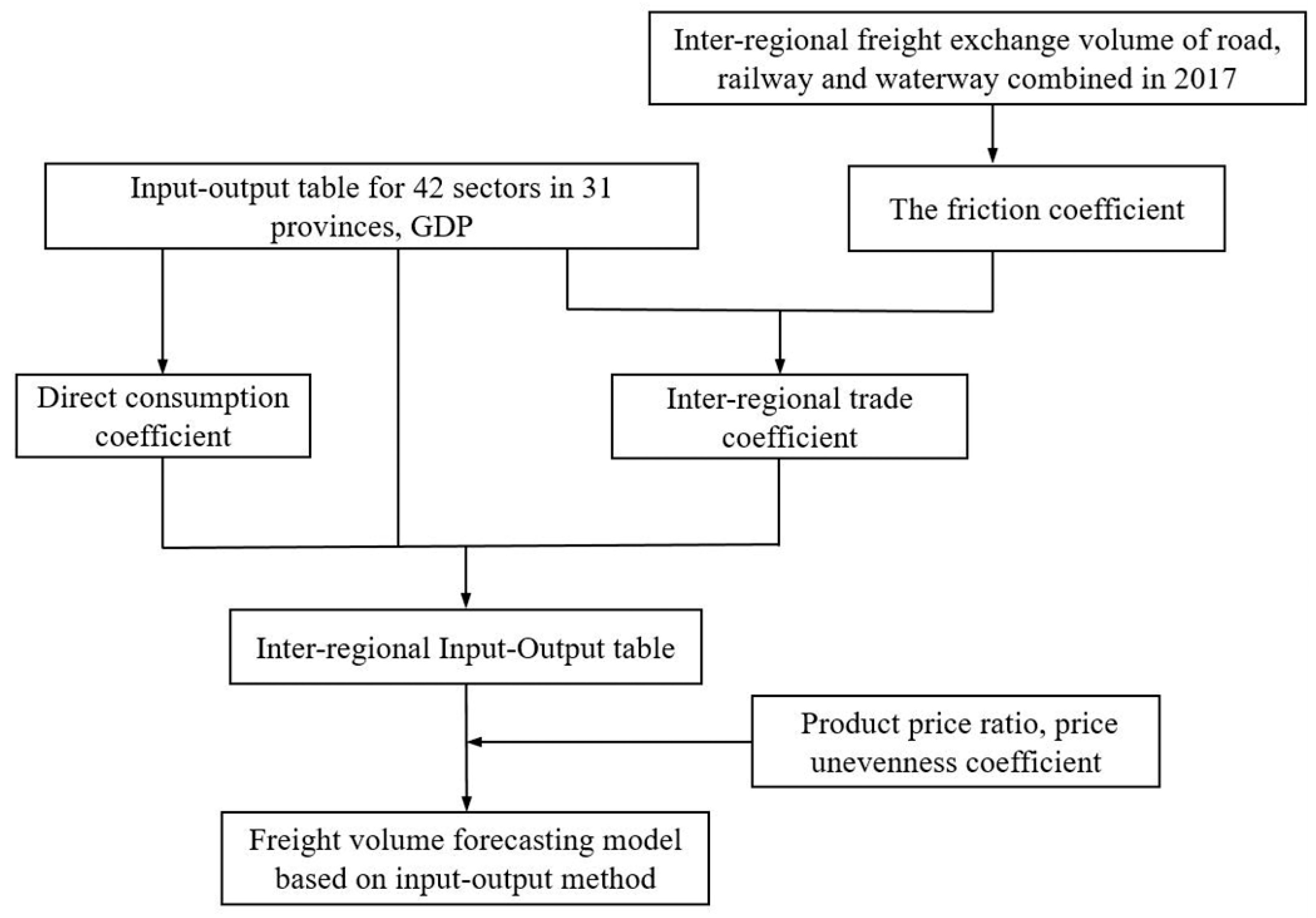

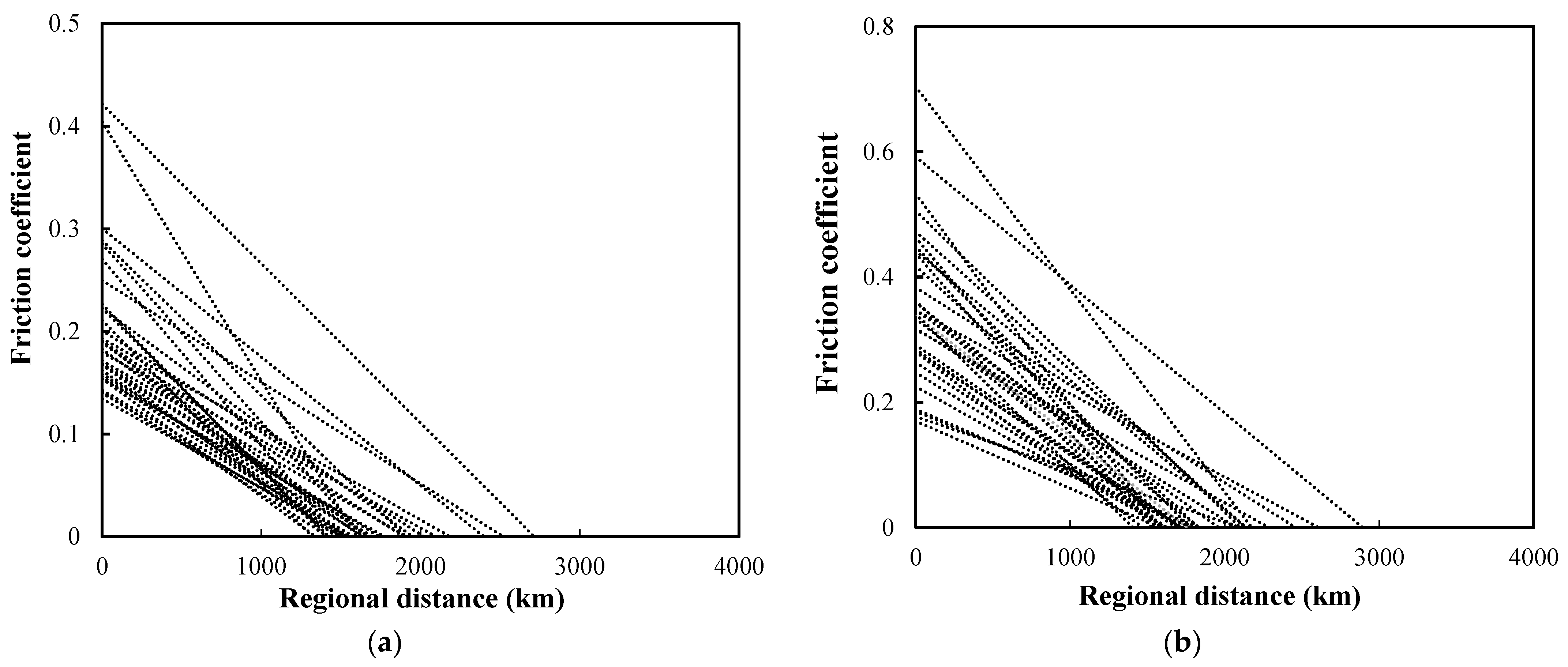

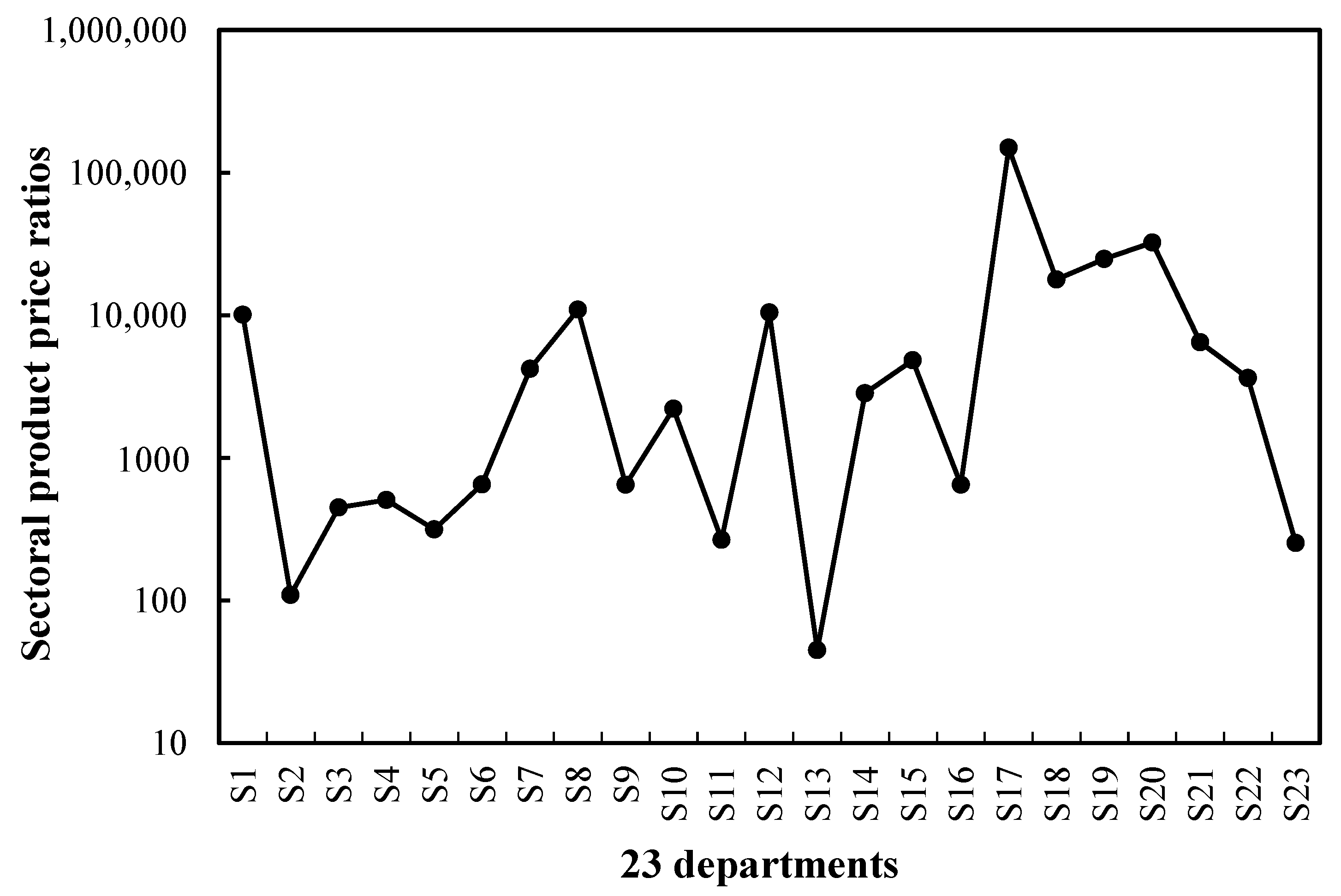



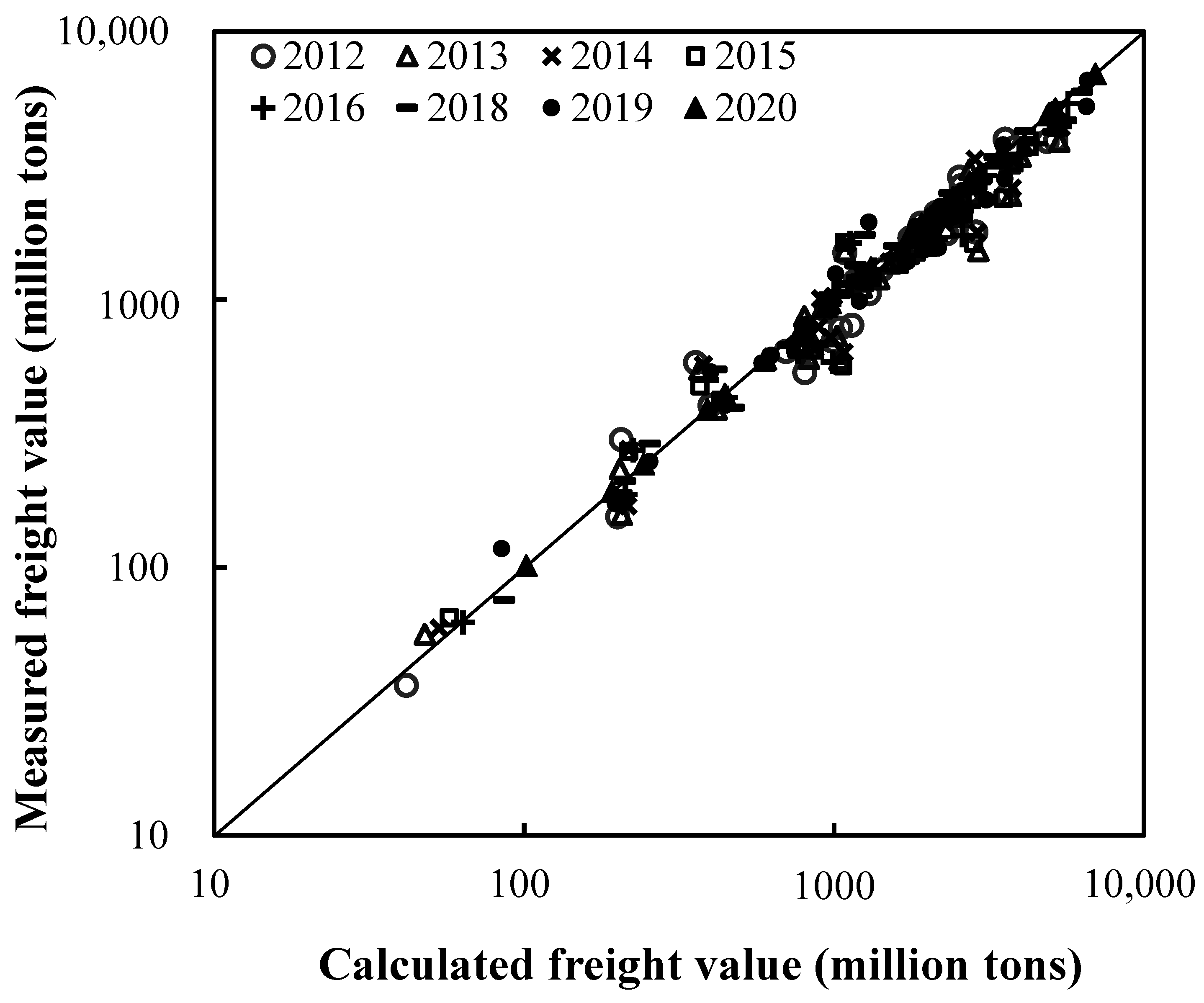
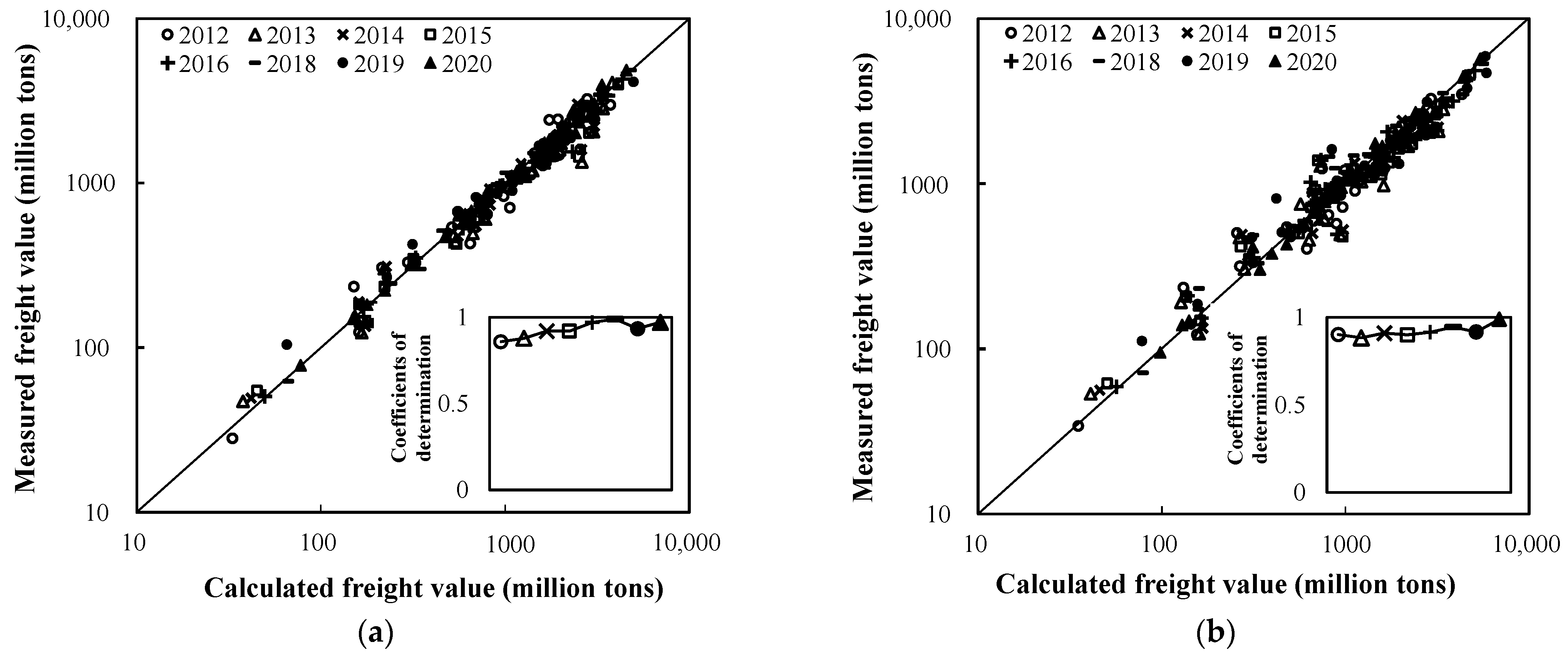

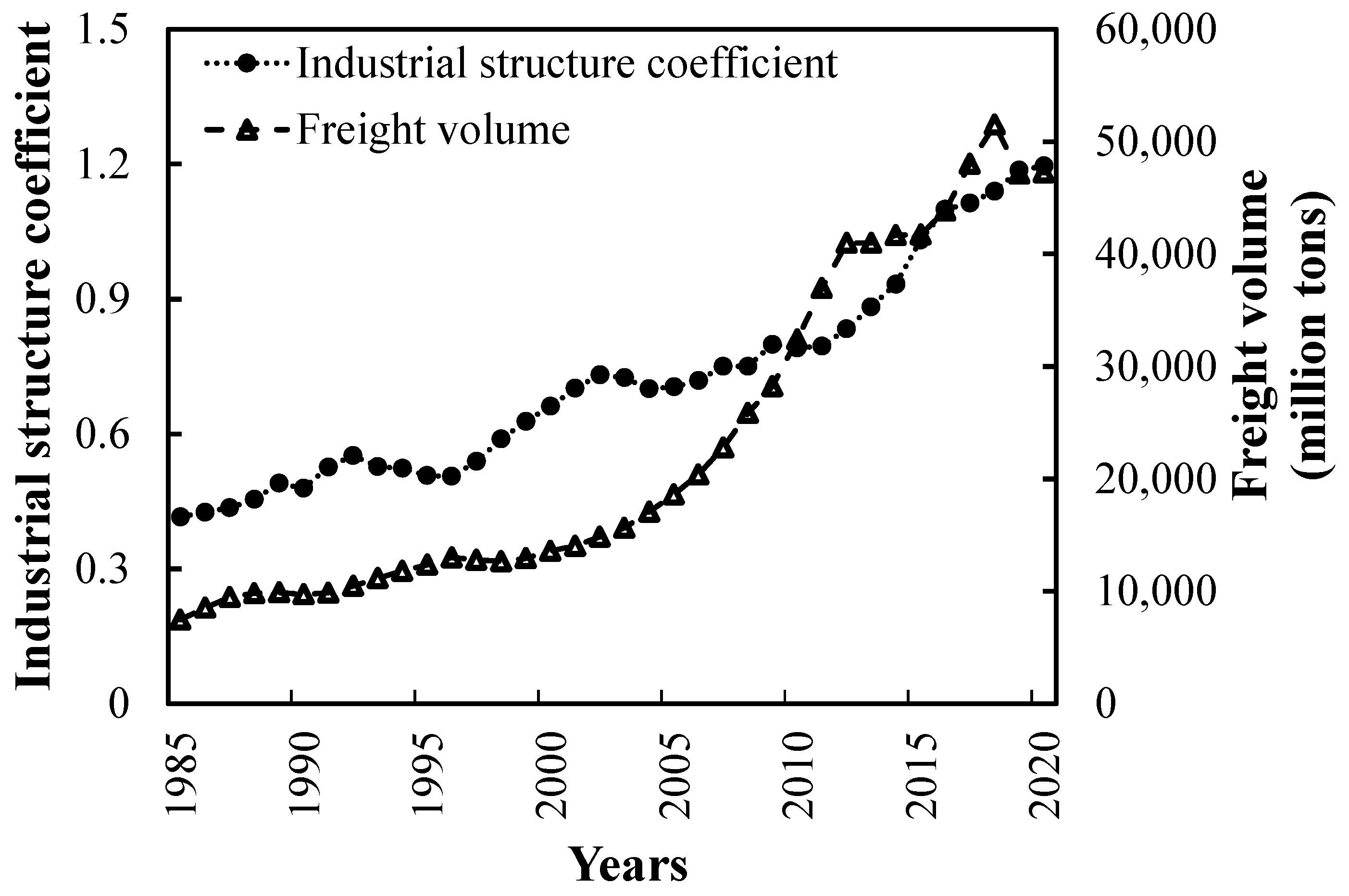
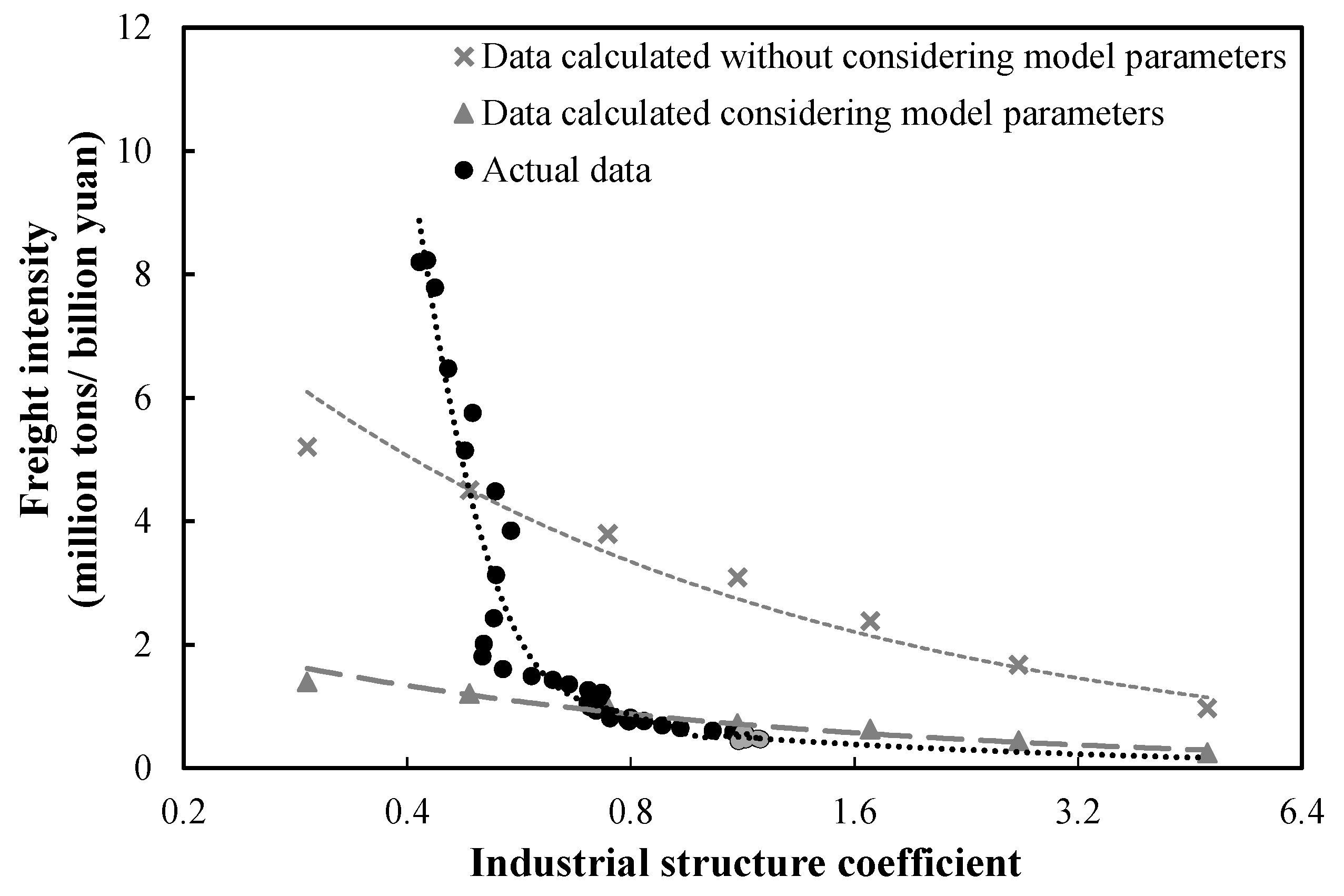
| Different Cases | The Primary Sector | The Secondary Sector | The Secondary Sector |
|---|---|---|---|
| Benchmark value | 7.4% | 39.9% | 52.7% |
| Case 1 | 7.4% | 69.9% (30% increased) | 22.7% (30% decreased) |
| Case 2 | 7.4% | 59.9% (20% increased) | 32.7% (20% decreased) |
| Case 3 | 7.4% | 49.9% (10% increased) | 42.7% (10% decreased) |
| Case 4 | 7.4% | 29.9% (10% decreased) | 62.7% (10% increased) |
| Case 5 | 7.4% | 19.5% (20% decreased) | 72.7% (20% increased) |
| Case 6 | 7.4% | 9.5% (30% decreased) | 82.7% (30% increased) |
Disclaimer/Publisher’s Note: The statements, opinions and data contained in all publications are solely those of the individual author(s) and contributor(s) and not of MDPI and/or the editor(s). MDPI and/or the editor(s) disclaim responsibility for any injury to people or property resulting from any ideas, methods, instructions or products referred to in the content. |
© 2023 by the authors. Licensee MDPI, Basel, Switzerland. This article is an open access article distributed under the terms and conditions of the Creative Commons Attribution (CC BY) license (https://creativecommons.org/licenses/by/4.0/).
Share and Cite
Li, W.; Luo, C.; He, Y.; Wan, Y.; Du, H. Estimating Inter-Regional Freight Demand in China Based on the Input–Output Model. Sustainability 2023, 15, 9808. https://doi.org/10.3390/su15129808
Li W, Luo C, He Y, Wan Y, Du H. Estimating Inter-Regional Freight Demand in China Based on the Input–Output Model. Sustainability. 2023; 15(12):9808. https://doi.org/10.3390/su15129808
Chicago/Turabian StyleLi, Wenjie, Chun Luo, Yiwei He, Yu Wan, and Hongbo Du. 2023. "Estimating Inter-Regional Freight Demand in China Based on the Input–Output Model" Sustainability 15, no. 12: 9808. https://doi.org/10.3390/su15129808






